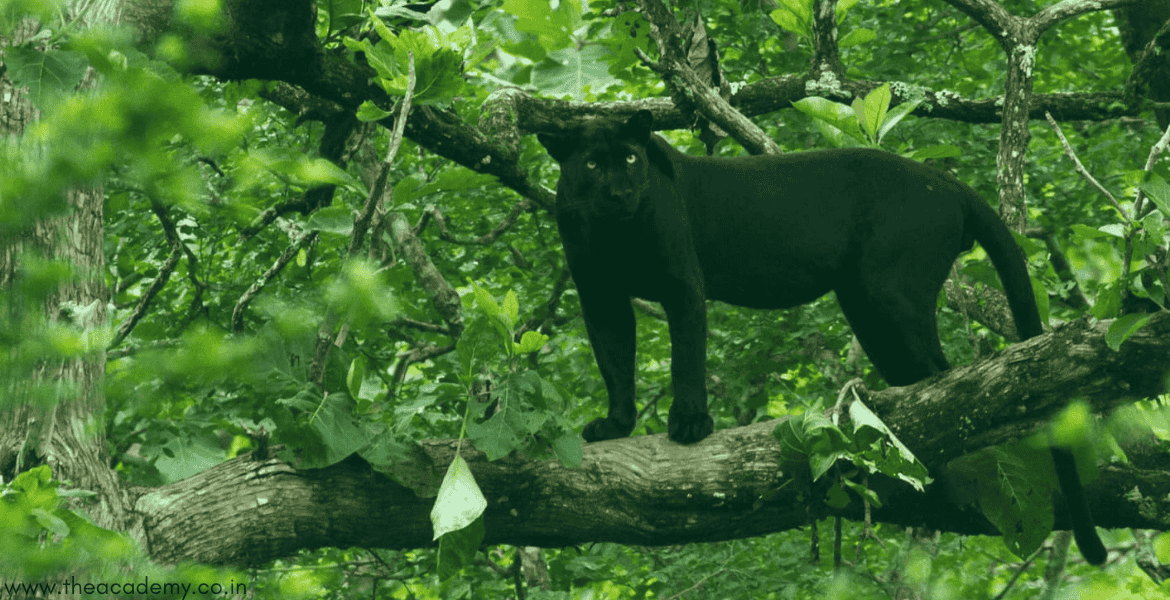. 08/10/2024 11:26 AM
In a groundbreaking discovery, the All Odisha Leopard Estimation-2024 has confirmed the presence of rare melanistic leopards, commonly known as black panthers, in three different forest divisions across Odisha. The survey, which spanned 47 forest divisions, marks a significant step in understanding the state's leopard population and the unique wildlife inhabiting Odisha's diverse landscapes. This discovery, however, brings with it the need for enhanced conservation measures to protect these rare animals from poaching and other threats.
A melanistic leopard is a leopard with a genetic mutation that causes its fur to appear black due to an excess of melanin, the dark pigment found in the skin. Despite their dark coat, the rosette patterns characteristic of leopards are still visible under certain lighting conditions. These black panthers are not a separate species but a color variant of the common leopard (Panthera pardus). Their dark coloration offers better camouflage in dense forests, making them more suited for survival in those environments. However, melanistic leopards are incredibly rare, accounting for only about 11% of the leopard population in regions like Africa and Asia.

The discovery of black panthers in Odisha’s forests has added a new layer to the state's rich wildlife heritage. So far, Odisha’s Similipal Tiger Reserve (STR) was already recognized for hosting melanistic Royal Bengal Tigers (RBT), a unique lineage that features both black and yellow stripes on the tigers’ bodies. Now, the confirmed presence of black panthers in the state adds another unique species to its roster.
Pradeep Kumar Mirase, Divisional Forest Officer (DFO) of Sundargarh, shared that the first black panther was spotted in the Hemgir region of Sundargarh district. The sighting was made possible by trap cameras set up during the survey. Additionally, protection squads stationed in the forests have also sighted the black panther multiple times. To ensure their protection from poachers, the exact numbers and locations of these animals are being withheld. More camera traps are expected to be installed in the future to track their movements.
The All Odisha Leopard Estimation-2024 was conducted in response to discrepancies in the National Tiger Conservation Authority’s (NTCA) previous survey, which reported a significant decline in leopard numbers from 760 in 2018 to 568 in 2022. The Odisha government expressed concerns over these findings and, in May 2024, launched its own census to gather more accurate data.
The state’s forest department employed a variety of techniques for this detailed leopard count, including:
-Pugmarks (paw prints)
-Scats (droppings)
-Vocalizations (leopard sounds)
-Sign surveys (such as scrapes, rakes, and urine spray)
-Camera traps strategically placed across various forests
-Evidence from livestock depredation
A total of 284 cameras were used across the state, alongside other methods like line transect sampling and distance sampling to estimate the abundance of the wild leopard population. These methods proved to be more reliable than the NTCA’s 2018 survey, which primarily relied on camera traps in limited areas and statistical models, resulting in an error margin of 35%. In contrast, the Odisha survey’s error margin was less than 10%, making the findings far more accurate.
The All Odisha Leopard Estimation-2024 revealed that the state is home to 696 leopards, an increase of 128 from previous counts. Despite this positive growth, the number is still lower than the 760 leopards reported in the NTCA’s 2018 survey. Odisha’s Similipal Tiger Reserve, which spans 2,750 square kilometers, remains the key habitat for leopards in the state, followed by the Satkosia landscape, which has emerged as another significant site with a growing leopard population.
While the discovery of black panthers and the increased leopard population is encouraging, poaching remains a major concern. Between 2018 and 2023, as many as 59 leopard skins were seized from smugglers in Odisha, highlighting the ongoing threat to these magnificent creatures. With the rare black panthers now confirmed in the state, conservationists are on high alert, and steps are being taken to keep their locations secret to prevent them from becoming targets of poaching.
The presence of rare melanistic leopards in Odisha calls for focused conservation efforts to ensure the long-term survival of these animals. The state’s forest department has already set up protection squads and installed more cameras in the forest areas where these black panthers have been spotted. Additionally, with the increasing number of leopards in Odisha, there is a growing need for continued surveillance and stricter enforcement of anti-poaching laws to protect these species from illegal hunting.
The discovery of black panthers alongside melanistic Royal Bengal Tigers cements Odisha’s position as a critical region for wildlife diversity and conservation. Moving forward, enhanced efforts to monitor, protect, and conserve the state's rich fauna will be essential to ensuring the survival of these rare and majestic creatures.
The findings of the All Odisha Leopard Estimation-2024 have shed light on the state's growing leopard population and the presence of rare black panthers in its forests. These discoveries are a testament to the rich biodiversity of Odisha, but they also underline the urgent need for conservation efforts to protect these vulnerable animals from poaching and habitat loss. With careful monitoring, strategic protection, and community awareness, Odisha can ensure that its unique wildlife thrives for generations to come.